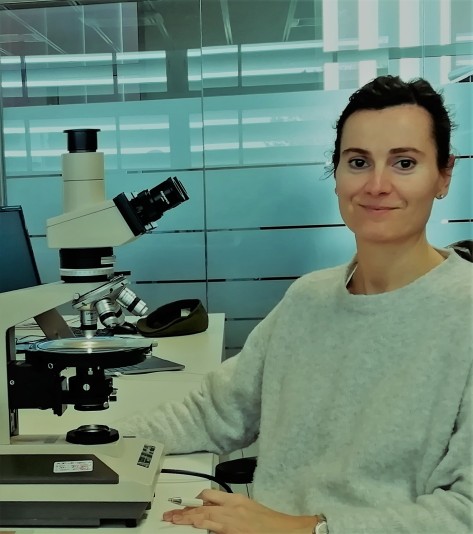NewsNext Previous
Research collaboration between the IPHES and the University of La Laguna to study how the last hunter-gatherers in the Iberian Peninsula used fire
The IPHES researcher, Ana Polo, recently carried out a research stay at the AMBI LAB Archaeological Micromorphology and Biomarker Lab of the University of La Laguna to promote scientific collaboration between the PALEODEM European project of this research centre in Tarragona and the PALEOCHAR project in the Canary Islands. Both projects include, among their main objectives, the microscopic study of sediments from archaeological hearths to provide information on human behaviour and climate changes during Prehistory.
The IPHES postdoctoral researcher, Ana Polo Díaz, completed a three-week research stay at the Archaeological Micromorphology and Biomarker AMBI Lab of the University of La Laguna (Tenerife, Spain). The aim of the visit was to establish scientific collaboration between the interdisciplinary research teams of the ERC projects PALEODEM (Ref. 683018) and PALEOCHAR (Ref. 648871) led by Dr. Javier Fernández López de Pablo (IPHES) and Dr. Carolina Mallol (ULL), respectively.
Both projects include among their main objectives the study of sediments from archaeological hearths on a microscopic scale. The aim of these investigations is to understand how groups of prehistoric hunter-gatherer societies in Southwestern Europe used fire as well as associated domestic activities; the purpose is to offer a clearer picture of their ways of life, how they exploited natural resources and how they adapted to climate challenges.
In Tenerife, Ana Polo had the opportunity to discuss various aspects of the formation process of approximately 9,000-year-old Mesolithic hearth-pits documented in the site of El Arenal de la Virgen (Villena, Alicante) with AMBI Lab’s scientific staff. Similarly, she was able to consult the laboratory’s extensive reference collection of thin films from sites with evidence of occupation by hunter-gatherers who inhabited Europe over the last 50,000 years.

Dissemination work was equally carried out during her stay to circulate the objectives, challenges and geoarchaeological research methods applied to the study of both archaeological sites excavated within the framework of the PALEODEM project: El Arenal de la Virgen and Casa Corona. As part of this task, the researcher shared the results of the sediments’ taphonomy (alterations) obtained from her study of both sites mentioned above and explained the role that human activities and natural processes had in accumulating and altering archaeological deposits. Ana Polo also highlighted the implications of these results: they allow us to better understand the impact of taphonomy on archaeological sites and, therefore, our ability to extract information from them and interpret the past.
This dissemination work included a didactic session in AMBI-LAB on microscopy and the presentation of results as well as a guest lecture, held on 21 November, called Integrative Geoarchaeological Approaches to the Investigation of Mesolithic Campsites in SE Iberia.
Ana Polo’s stay received financial support from the European Commission through the ERC PALEODEM project.


